Scalable Implementation of Hippocampal Network on Digital Neuromorphic System towards Brain-Inspired Intelligence
Abstract
1. Introduction
2. The Hippocampal Neural Network Model
3. Digital Implementation
3.1. Network-On-Chip (NoC) Architecture
| Algorithm 1: The HIP router for routing the packets in torus-based NoC |
| loop if posedge clk then Δx1=XC-1; Δx2= WN-XC; //WN: Width of the NoC, XC: xcurrent Δy1=YC-1; Δy2= HN-YC; // HN: Height of the NoC, YC: ycurrent Δxsign <-((xdest-XC) > 0)?0:l Δysign <- ((ydest-YC) > 0)?0:l if Δxsign = 0 then Δx<- (xdest-XC); Δxreverse<- (WN -xdest) + XC; if Δx ≤ Δxreverse then Route the packet EAST; else Route the packet WEST; end if else {Δxsign != 0}; Δx<- (XC-xdest); Δxreverse<- (WN -XC) + xdest; if Δx ≤ Δxreverse then Route the packet WEST; else Route the packet EAST; end if end if if Δysign = 0 then Δy<- (ydest-YC); Δyreverse <- (HN -ydest) + YC; if Δy ≤ Δyreverse then Route the packet SOUTH; else Route the packet NORTH; end if else {Δysign != 0}; Δy<- (YC-ydest); /Δyreverse <- (HN -YC) + ydest; if Δy ≤ Δyreverse then Route the packet NORTH; else Route the packet SOUTH; end if end if if XC=1 or XC=WN or YC=1 or YC= HN then Route the packet UP; // The situation that the current node is the edge node elseif Δxl>=Δx2 then Route the packet West; else Route the packet East; end if end if end loop |
3.2. CORDIC-Based Neuron Design
3.3. Neuron Implementation
4. Experimental Results
5. Conclusions
Author Contributions
Funding
Conflicts of Interest
References
- Wang, Y.; Huang, L.; Zhang, W.; Zhang, Z.; Cacioppo, S. Spatio-temporal dynamics of kind versus hostile intentions in the human brain: An electrical neuroimaging study. Soc. Neurosci. 2015, 10, 253–267. [Google Scholar] [CrossRef]
- Tajima, S.; Yanagawa, T.; Fujii, N.; Taro, T. Untangling Brain-Wide Dynamics in Consciousness by Cross-Embedding. PLoS Comput. Biol. 2015, 11, e1004537. [Google Scholar] [CrossRef]
- Sengupta, A.; Ye, Y.; Wang, R.; Liu, C.; Roy, K. Going Deeper in Spiking Neural Networks: VGG and Residual Architectures. Front. Neurosci. 2018, 13, 95. [Google Scholar] [CrossRef]
- Li, W.; Papilloud, A.; Laura, L.M.; Zhao, N.; Ye, X.; Zhang, X.; Carmen, S.; Gregor, R. Stress Impacts the Regulation Neuropeptides in the Rat Hippocampus and Prefrontal Cortex. Proteomics 2018, 18, 700408. [Google Scholar] [CrossRef]
- Guo, L.; Zhang, W.; Zhang, J. Neural information coding on small-world spiking neuronal networks modulated by spike-timing-dependent plasticity under external noise stimulation. Clust. Comput. 2019, 22, 5217–5231. [Google Scholar] [CrossRef]
- Caitlin, R.B.; Dagmar, Z. Abstract Memory Representations in the Ventromedial Prefrontal Cortex and Hippocampus Support Concept Generalization. J. Neurosci. Off. J. Soc. Neurosci. 2018, 38, 2605–2614. [Google Scholar]
- Pandey, A.; Sikdar, S.K. Depression biased non-Hebbian spike-timing-dependent synaptic plasticity in the rat subiculum. J. Physiol. 2014, 592, 3537–3557. [Google Scholar] [CrossRef]
- Lu, C.W.; Huang, S.K.; Lin, T.Y.; Wang, S.J. Echinacoside, an active constituent of Herba Cistanche, suppresses epileptiform activity in hippocampal CA3 pyramidal neurons. Korean J. Physiol. Pharm. 2018, 22, 49. [Google Scholar] [CrossRef]
- Klyne, D.M.; Moseley, G.L.; Sterling, M.; Barbe, M.F.; Hodges, P.W. Individual Variation in Pain Sensitivity and Conditioned Pain Modulation in Acute Low Back Pain: Impact of Stimulus Type, Sleep, Psychological and Lifestyle Factors. J. Pain Off. J. Am. Pain Soc. 2018, 19, 942.e1–942.e18. [Google Scholar] [CrossRef]
- Venkatesh, G.K.; Nadarajan, R.A. HTTP botnet detection using adaptive learning rate multilayer feed-forward neural network. In Proceedings of the Ifip Wg 112 International Conference on Information Security Theory & Practice: Security; Springer: Berlin/Heidelberg, Germany, 2017. [Google Scholar]
- George, P.; Simon, H.; Howard, B. The Sync/deSync Model: How a Synchronized Hippocampus and a Desynchronized Neocortex Code Memories. J. Neurosci. Off. J. Soc. Neurosci. 2018, 38, 3428–3440. [Google Scholar]
- Adler, D.H.; Wisse, L.E.M.; Ittyerah, R.; Pluta, J.B.; Ding, S.L.; Xie, L.; Wang, J.; Kadivar, S.; Robinson, J.L.; Schuck, T.; et al. Characterizing the human hippocampus in aging and Alzheimer’s disease using a computational atlas derived from ex vivo MRI and histology. Proc. Natl. Acad. Sci. USA 2018, 115, 201801093. [Google Scholar] [CrossRef]
- Karita, S.T.; Tuomas, P.M.; Selja, M.I.V.; Risto, J.I. EEG Artifact Removal in TMS Studies of Cortical Speech Areas. Brain Topogr. 2020, 33, 1–9. [Google Scholar]
- Nickl, R.C.; Reich, M.M.; Pozzi, N.G.; Patrick, F.; Florian, L.; Jonas, R.; Volkmann, J.; Matthies, C. Rescuing Suboptimal Outcomes of Subthalamic Deep Brain Stimulation in Parkinson Disease by Surgical Lead Revision. Neurosurgery 2019, 85, 2. [Google Scholar] [CrossRef]
- Bauer, P.R.; Kalitzin, S.; Zijlmans, M.; Sander, J.W.; Visser, G. Cortical Excitability as a Clinical Marker in Epilepsy: A review of the clinical application of Transcranial Magnetic Stimulation. Int. J. Neural Syst. 2014, 24, 1430001. [Google Scholar] [CrossRef]
- Roberto, F.L.; Patrice, A.; Herwig, W.; Stéphane, J.; Hugo, T. A Generalized Multifractal Formalism for the Estimation of Nonconcave Multifractal Spectra. IEEE Trans. Signal Process. 2019, 67, 110–119. [Google Scholar]
- Mccafferty, C.; François, D.; Venzi, M.; Lorincz, M.; Francis, D.; Zoe, A.; Recchia, G.; Orban, G.; Lambert, R.C.; di Giovanni, G. Cortical drive and thalamic feed-forward inhibition control thalamic output synchrony during absence seizures. Nat. Neurosci. 2018, 21 (Suppl. 9), 6. [Google Scholar] [CrossRef]
- Satarupa, D.; Sumalee, S.; Stella, M.; Surjith, K.; Carlo, M.; Sinoj, A. Light-induced ATP driven self-assembly of actin heavy-meromyosin in a proteo-tubularsomes as a step toward an artificial cell. Chem. Commun. 2018, 54. [Google Scholar]
- Mccormick, C.; Ciaramelli, E.; Luca, F.D.; Maguire, E.A. Comparing and Contrasting the Cognitive Effects of Hippocampal and Ventromedial Prefrontal Cortex Damage: A Review of Human Lesion Studies. Neuroscience 2018, 374, 295–318. [Google Scholar] [CrossRef]
- Shashikant, K.; Timothy, K.H. Waypoint Path Planning with Synaptic-Dependent Spike Latency. IEEE Trans. Circuits Syst. I: Regul. Pap. 2019, 6, 1544–1557. [Google Scholar]
- Caleb, J.; Kannan, M. VLSI Implementation of Constructive Neural Network for Skin Cancer Detection. J. Comput. Nanosci. 2018, 15, 485–492. [Google Scholar] [CrossRef]
- Hargreaves, S.; Bath, P.; Duffin, S.; Ellis, J. Sharing and empathy in digital spaces: Qualitative study of online health forums for breast cancer and motor neuron disease. (Amyotrophic Lateral Sclerosis). J. Med. Internet Res. 2018, 20, 222. [Google Scholar] [CrossRef] [PubMed]
- Yang, S.; Wang, J.; Li, S.; Li, H.; Wei, X.; Yu, H.; Deng, B. Digital implementations of thalamocortical neuron models and its application in thalamocortical control using FPGA for Parkinson’s disease. Neurocomputing 2016, 177, 274–289. [Google Scholar] [CrossRef]
- Luo, Y.; Wan, L.; Liu, J.; Harkin, J.; Cao, Y. An efficient, low-cost routing architecture for spiking neural network hardware implementations. Neural Process. Lett. 2018, 48, 1–12. [Google Scholar] [CrossRef]
- Yang, S.; Wang, J.; Li, S.; Deng, B.; Wei, X.; Yu, H.; Li, H. Cost-efficient FPGA implementation of basal ganglia and their Parkinsonian analysis. Neural Netw. 2015, 71, 62–75. [Google Scholar] [CrossRef]
- Yang, S.; Wei, X.; Wang, J.; Deng, B.; Liu, C.; Yu, H.; Li, H. Efficient hardware implementation of the subthalamic nucleus–external globus pallidus oscillation system and its dynamics investigation. Neural Netw. 2017, 94, 220–238. [Google Scholar] [CrossRef]
- Kuang, Z.; Wang, J.; Yang, S.; Yi, G.; Deng, B.; Wei, X. Digital Implementation of the Spiking Neural Network and Its Digit Recognition. In Proceedings of the 2019 Chinese Control and Decision Conference (CCDC), Nanchang, China, 3–5 June 2019. [Google Scholar]
- Sebastian, W.; Navaridas, J.; Mikel, L. A survey on optical network-on-chip architectures. ACM Comput. Surv. 2017, 50, 1–37. [Google Scholar]
- Yang, S.; Wang, J.; Deng, B.; Liu, C.; Li, H.; Fietkiewicz, C.; Loparo, K.A. Real-time neuromorphic system for large-scale conductance-based spiking neural networks. IEEE Trans Cybern. 2018, 49, 2490–2503. [Google Scholar] [CrossRef]
- Ayyldz, N.; Schmidt, E.G.; Güran, H.C. S-DIRECT: Scalable and Dynamically Reconfigurable TCAM Architecture for High-Speed IP Lookup. Comput. J. 2018, 58, 1443–1455. [Google Scholar]
- Jand, A.; Taheri-Nejad, M.R.; Mosleh, M.; Palizvan, M.R. Low, but Not High, Doses of Copper Sulfate Impair Synaptic Plasticity in the Hippocampal CA1 Region In Vivo. Biol. Trace Elem. Res. 2018, 185, 1–5. [Google Scholar] [CrossRef]
- Maícas, R.J.; Leng, G.; MacGregor, D.J. A Predictive, Quantitative Model of Spiking Activity and Stimulus-Secretion Coupling in Oxytocin Neurons. Endocrinology 2018, 159, 3. [Google Scholar] [CrossRef]
- Hao, J.; Hao, X.; Wang, J.; Yang, S.; Deng, B.; Yu, H. Behavior of a Hippocampal Spiking Network and FPGA Implementation. In Proceedings of the 2019 Chinese Control Conference (CCC), Guangzhou, China, 27–30 July 2019; pp. 8433–8438. [Google Scholar]
- Yang, S.; Deng, B.; Li, H.; Liu, C.; Wang, J.; Yu, H.; Qin, Y. FPGA implementation of hippocampal spiking network and its real-time simulation on dynamical neuromodulation of oscillations. Neurocomputing 2018, 282, 262–276. [Google Scholar] [CrossRef]
- Yang, S.; Wang, J.; Deng, B.; Wei, X.; Li, H.; Wang, T. FPGA-based spiking neural network with hippocampal oscillation dynamics towards biologically meaningful prostheses. In Proceedings of the 2018 13th World Congress on Intelligent Control and Automation (WCICA), Changsha, China, 4–8 July 2018. [Google Scholar]
- Hu, J.; Deng, B.; Yang, S.; Wei, X.; Wang, J. A real-time virtual manipulator simulation platform based on FPGA. In Proceedings of the 2019 Chinese Control Conference (CCC), Guangzhou, China, 27–30 July 2019; pp. 3114–3119. [Google Scholar]
- Li, H.; Yang, S.; Hao, X.; Wang, J.; Deng, B.; Yi, G. Real-time implementation of the Purkinje network on digital neuromorphic system. In Proceedings of the 2019 Chinese Control and Decision Conference (CCDC), Nanchang, China, 3–5 June 2019; pp. 3632–3637. [Google Scholar]
- Yang, S.; Wang, J.; Deng, B.; Li, H.; Che, Y. Digital Implementation of the Retinal Spiking Neural Network under Light Stimulation. In Proceedings of the 2019 9th International IEEE/EMBS Conference on Neural Engineering (NER), San Francisco, CA, USA, 20–23 March 2019; pp. 542–545. [Google Scholar]
- Dang, L.M. A survey on internet of things and cloud computing for healthcare. Electronics 2019, 8, 768. [Google Scholar] [CrossRef]
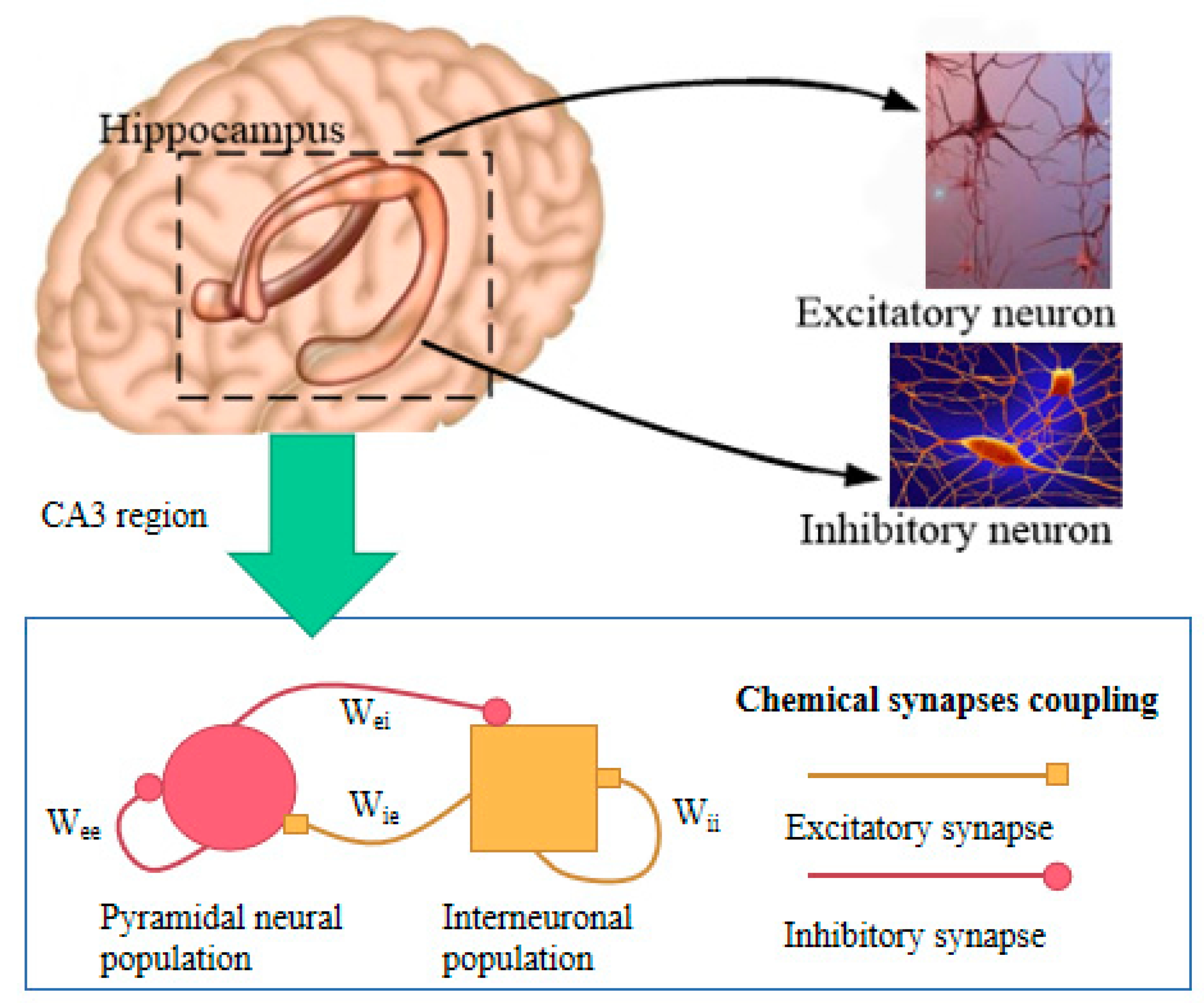
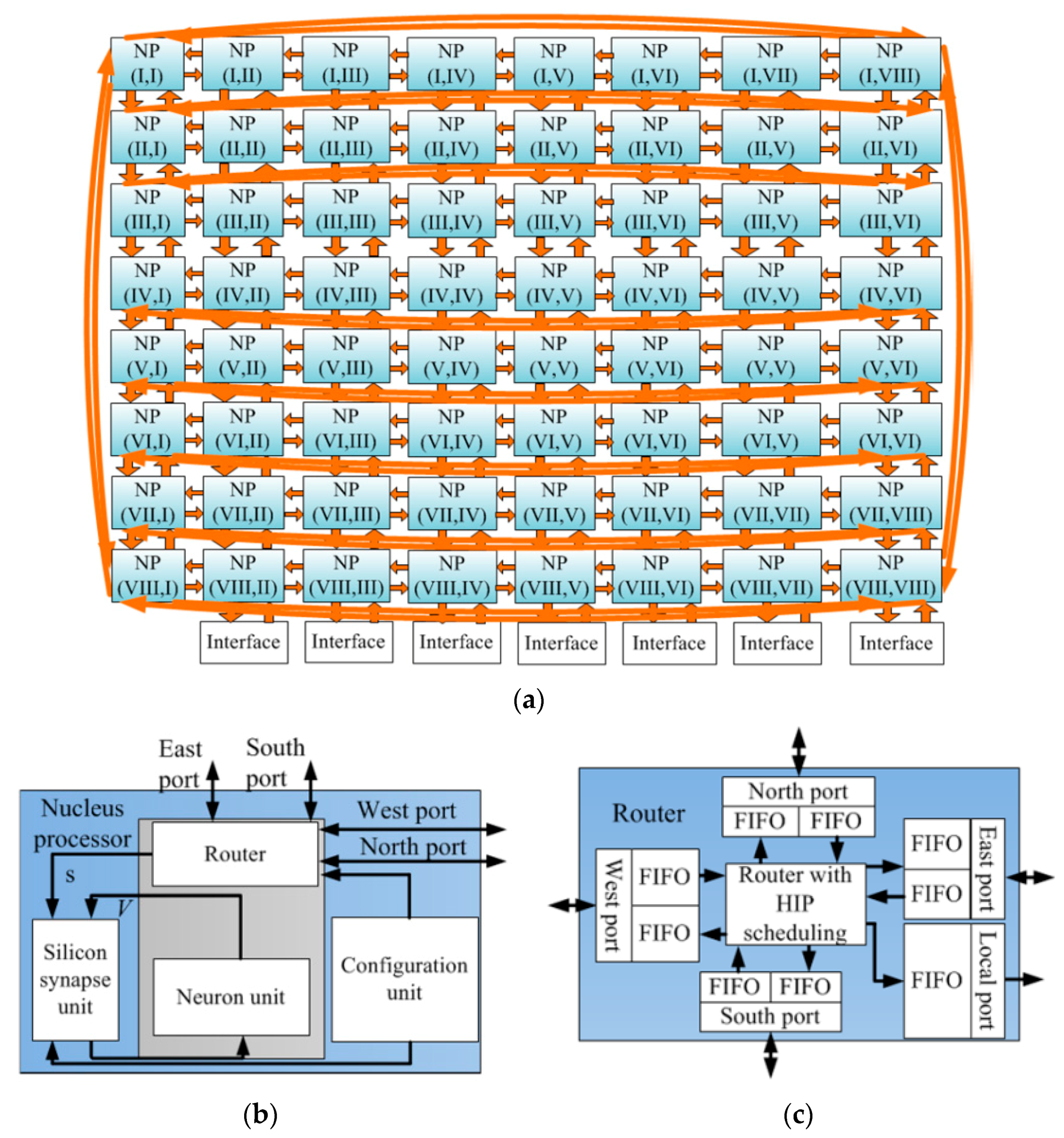
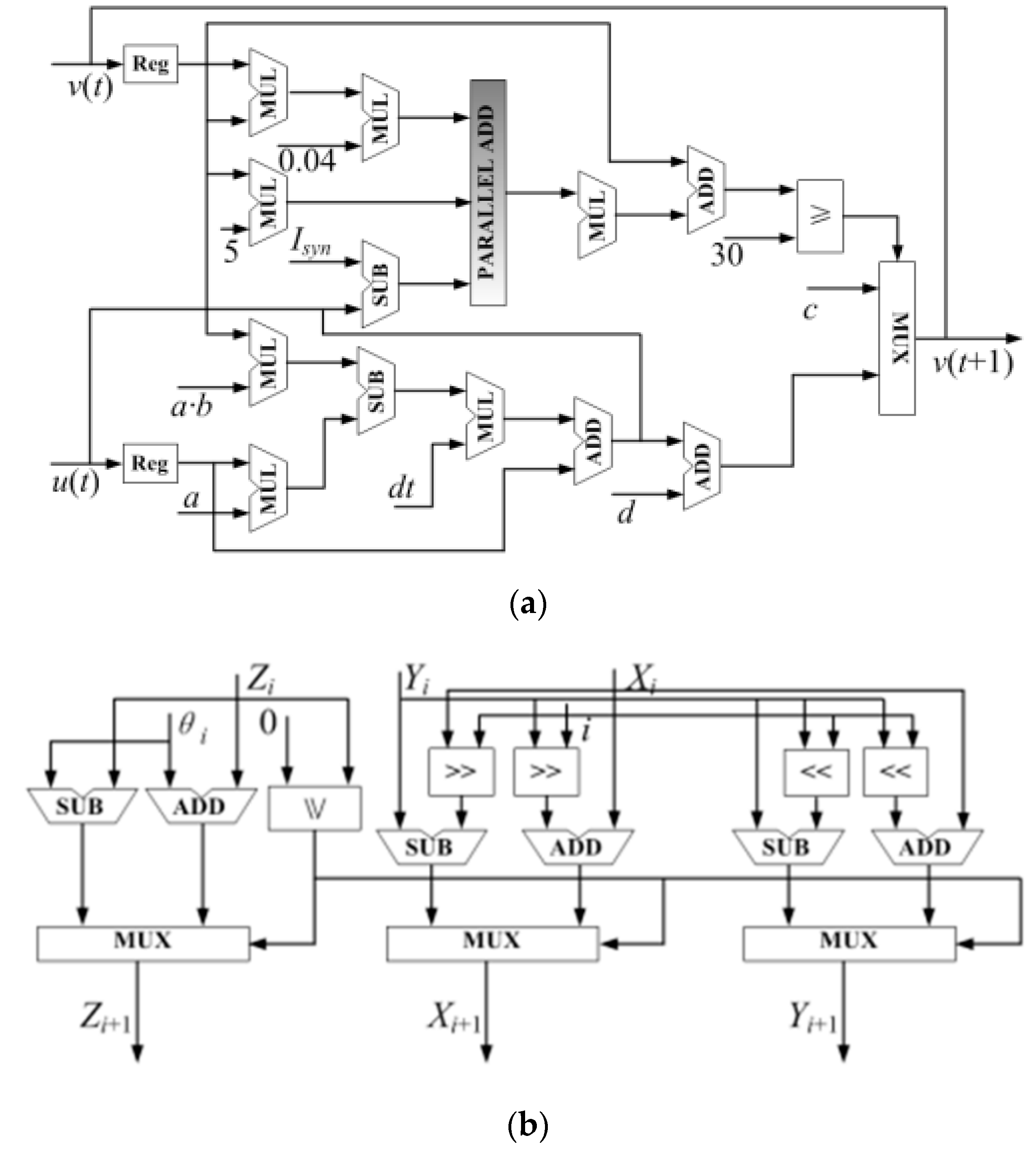
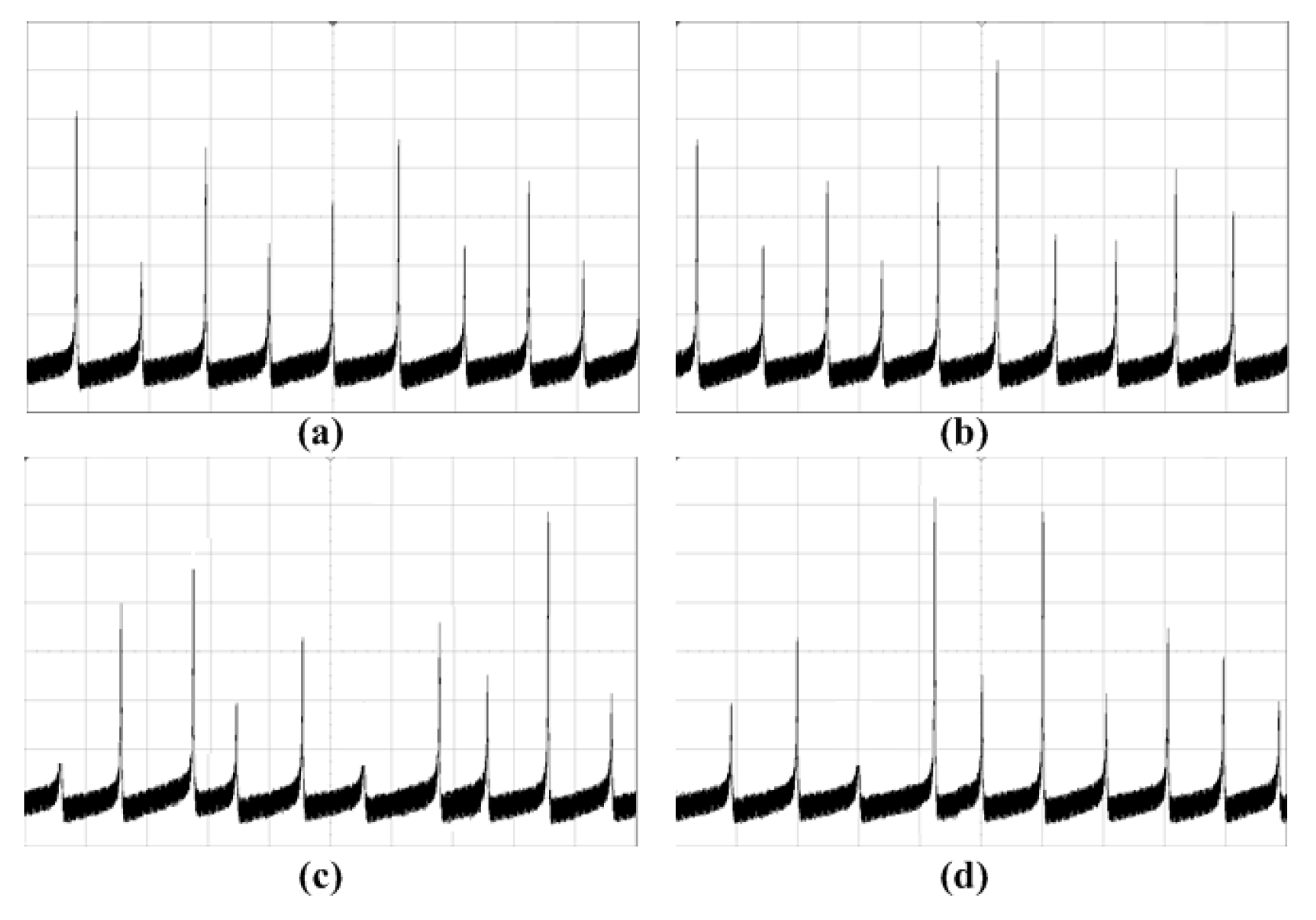
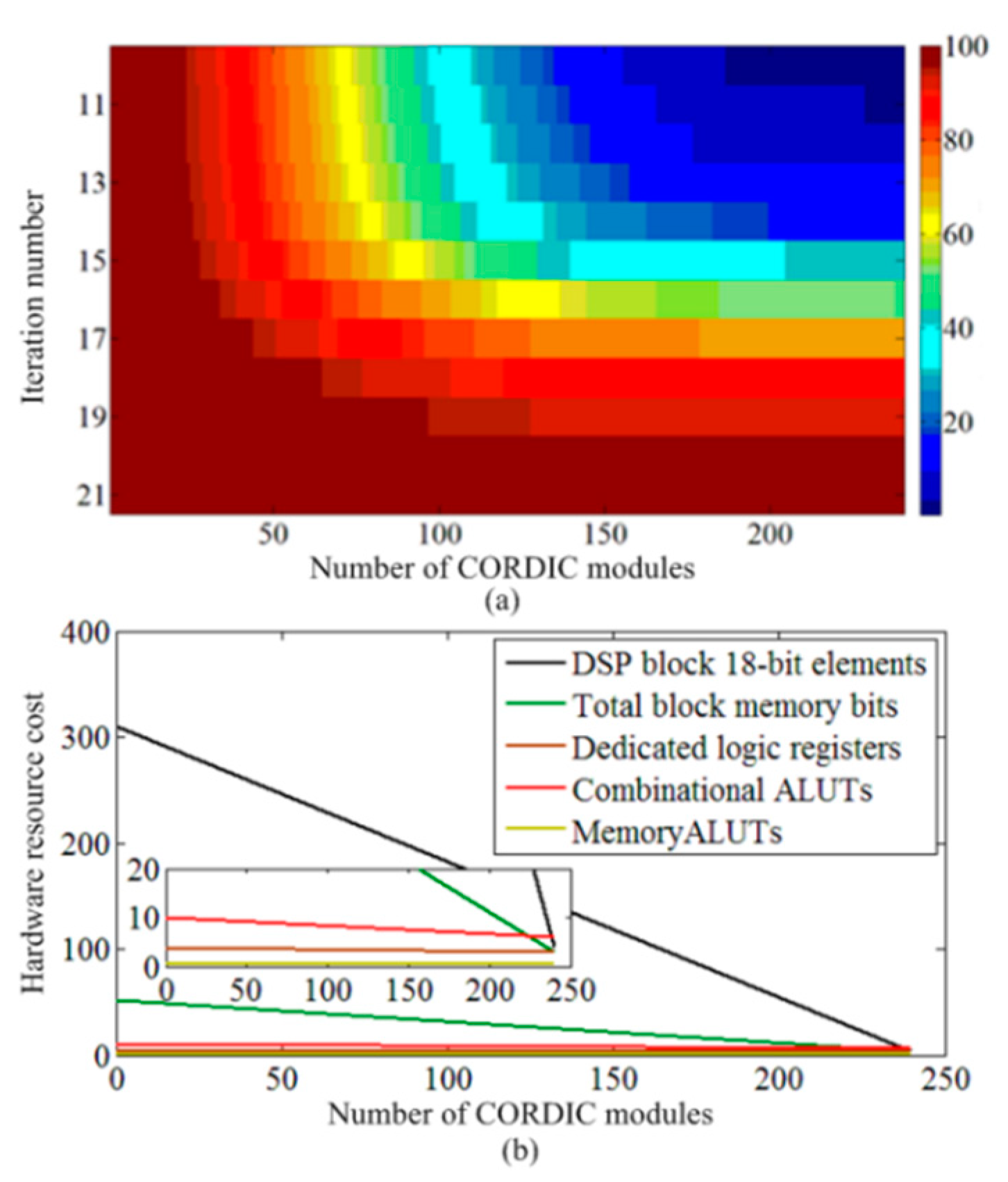

| Excitatory Neuron | Inhibitory Neuron | |
|---|---|---|
| a | 0.04 | 0.04 |
| b | 5 | 5 |
| c | 140 | 140 |
| τu | 43 ± 4.3 | 100 ± 0 |
| ku | 0.24 ± 0.02 | 0.25 ± 0 |
| V0 | −65 ± 6.5 | −65 ± 0 |
| ΔU | 10 ± 1 | 1 ± 0 |
| Resources | Conventional | CORDIC-Based |
|---|---|---|
| Combinational ALUTs | 19,652/203,520 (10%) | 10,642/203,520 (5%) |
| Memory ALUTs | 490/101,760 (<1%) | 712/101,760 (1%) |
| Dedicated logic registers | 8924/203,520 (4%) | 11,546/203,520 (6%) |
| Total block memory bits | 7,771,246/15,040,512 (52%) | 2106/15,040,512 (<1%) |
| DSP block 18-bit elements | 2384/768 (310%) | 0/768 (0%) |
| Total PLLs | 1/8 (13%) | 1/8 (13%) |
| Work | Motivation | Network Structure | Hardware Architecture |
|---|---|---|---|
| [27] | Visual pathway-inspired | Feedforward | No NoC design |
| [34] | Hippocampus-inspired | Feedforward | No NoC design |
| [36] | CPG-inspired | CPG | No NoC design |
| [37] | Purkinje-inspired | Recurrent | No NoC design |
| [38] | Retina-inspired | Feedforward | No NoC design |
| This study | Hippocampus-inspired | Recurrent | Torus-based NoC design |
© 2020 by the authors. Licensee MDPI, Basel, Switzerland. This article is an open access article distributed under the terms and conditions of the Creative Commons Attribution (CC BY) license (http://creativecommons.org/licenses/by/4.0/).
Share and Cite
Sun, W.; Wang, J.; Zhang, N.; Yang, S. Scalable Implementation of Hippocampal Network on Digital Neuromorphic System towards Brain-Inspired Intelligence. Appl. Sci. 2020, 10, 2857. https://doi.org/10.3390/app10082857
Sun W, Wang J, Zhang N, Yang S. Scalable Implementation of Hippocampal Network on Digital Neuromorphic System towards Brain-Inspired Intelligence. Applied Sciences. 2020; 10(8):2857. https://doi.org/10.3390/app10082857
Chicago/Turabian StyleSun, Wei, Jiang Wang, Nan Zhang, and Shuangming Yang. 2020. "Scalable Implementation of Hippocampal Network on Digital Neuromorphic System towards Brain-Inspired Intelligence" Applied Sciences 10, no. 8: 2857. https://doi.org/10.3390/app10082857
APA StyleSun, W., Wang, J., Zhang, N., & Yang, S. (2020). Scalable Implementation of Hippocampal Network on Digital Neuromorphic System towards Brain-Inspired Intelligence. Applied Sciences, 10(8), 2857. https://doi.org/10.3390/app10082857





